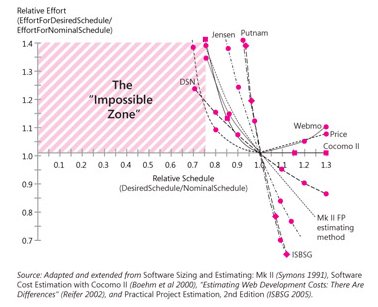Communications of the ACM
The Shortest Possible Schedule Theorem: Yes, You Can Throw Money at Software Deadlines

Some of the folk wisdom going around in software engineering, often cluessly repeated for decades, is just wrong. It can be particularly damaging when it affects key aspects of software development and is contradicted by solid scientific evidence. The present discussion covers a question that meets both of these conditions: whether it makes sense to add staff to a project to shorten its delivery time.
My aim is to popularize a result that is well known in the software engineering literature, going back to the early work of Barry Boehm [1], and explained with great clarity by Steve McConnell in his 2006 book on software cost estimation [2] under the name "Shortest Possible Schedule". While an empirical rather than a logical result, I believe it deserves to be called a theorem (McConnell stays shy of using the term) because it is as close as we have in the area of software engineering management to a universal property, confirmed by numerous experimental studies.
This article contributes no new concept since McConnell's chapter 20 says all there is to say about the topic; my aim is simply to make the Shortest Possible Schedule Theorem better known, in particular to practitioners.
The myth about shortening project times begins with an observation that is clearly correct, at least in an extreme form. Everyone understands that if our project has been evaluated, through accepted cost estimation techniques, to require three developers over a year we cannot magically hire 36 people to complete it in one month. Productivity does not always scale up.
But neither does common sense. Too often the conclusion from the preceding trival observation takes the form of an old saw, "Brooks' Law": adding people to a late project delays it further. The explanation is that the newcomers cost more through communication overhead than they bring through actual contributions. While a few other sayings of Brooks' Mythical Man-Month have stood the test of time, this one has always struck me as describing, rather than any actual law, a definition of bad management. Of course if you keep haplessly throwing people at deadlines you are just going to add communication problems and make things worse. But if you are a competent manager expanding the team size is one of the tools at your disposal to improve the state of a project, and it would be foolish to deprive yourself of it. A definitive refutation of the supposed law, also by McConnell, was published 20 years ago [3].
For all the criticism it deserves, Brooks's pronouncement was at least limited in its scope: it addressed addition of staff to a project that is already late. It is even wronger to apply it to the more general issue of cost-estimating and staffing software projects, at any stage of their progress. Forty-year-old platitudes have even less weight here. As McConnell's book shows, cost estimation is no longer a black art. It is not an exact science either, but techniques exist for producing solid estimates.
The Shortest Possible Schedule theorem is one of the most interesting results. Much more interesting than Brooks's purported law, because it is backed by empirical studies (rather than asking us to believe one person's pithy pronouncement), and instead of just a general negative view it provides a positive result complemented by a limitation of that result; and both are expressed quantitatively.
Figure 1 gives the general idea of the SPS theorem. General idea only; figure 2 will provide a more precise view.

Figure 1: General view of the Shortest Possible Schedule theorem.
The "nominal project" is the result of a cost and schedule estimation yielding the optimum point. The figure and the theorem provide project managers with both a reason to rejoice and a reason to despair:
- Rejoice: by putting in more money, i.e. more people (in software engineering, project costs are essentially people costs [4]), you can bring the code to fruition faster.
- Despair: whatever you do, there is a firm limit to the time you can gain: 25%. It seems to be a kind of universal constant of software engineering.
The "despair" part typically gets the most attention at first, since it sets an absolute value on how much money can buy (so to speak) in software: try as hard as you like, you will never get below 75% of the nominal (optimal) value. The "impossible zone" in Figure 1 expresses the fundamental limitation. This negative result is the reasoned and precise modern replacement for the older folk "law".
The positive part, however, is just as important. A 75%-empty glass is also 25%-full. It may be disappointing for a project manager to realize that no amount of extra manpower will make it possible to guarantee to higher management more than a 25% reduction in time. But it is just as important to know that such a reduction, not at all insignificant, is in fact reachable given the right funding, the right people, the right tools and the right management skills. The last point is critical: money by itself does not suffice, you need management; Brooks' law, as noted, is mostly an observation of the effects of bad management.
Figure 1 only carries the essential idea, and is not meant to provide precise numerical values. Figure 2, the original figure from McConnell's book, is. It plots effort against time rather than the reverse but, more importantly, it shows several curves, each corresponding to a published empirical study or cost model surveyed by the book.

Figure 2: Original illustration of the Shortest Possible Schedule
(figure 2-20 of [3], reproduced with the author's permission)
On the left of the nominal point, the curves show how, according to each study, increased cost leads to decreased time. They differ on the details: how much the project needs to spend, and which maximal reduction it can achieve. But they all agree on the basic Shortest Possible Schedule result: spending can decrease time, and the maximal reduction will not exceed 25%.
The figure also provides an answer, although a disappointing one, to another question that arises naturally. So far this discussion has assumed that time was the critical resource and that we were prepared to spend more to get a product out sooner. But sometimes it is the other way around: the critical resource is cost, or, concretely, the number of developers. Assume that nominal analysis tells us that the project will take four developers for a year and, correspondingly, cost 600K (choose your currency). We only have a budget of 400K. Can we spend less by hiring fewer developers, accepting that it will take longer?
On that side, right of the nominal point in Figure 2, McConnell's survey of surveys shows no consensus. Some studies and models do lead to decreased costs, others suggest that with the increase in time the cost will actually increase too. (Here is my interpretation, based on my experience rather than on any systematic study: you can indeed achieve the original goal with a somewhat smaller team over a longer period; but the effect on the final cost can vary. If the new time is t'= t + T and the new team size s'= s - S, t and s being the nominal values, the cost difference is proportional to Ts - t'S. It can be positive as well as negative depending on the values of the original t and s and the precise effect of reduced team size on project duration.)
The firm result, however, is the left part of the figure. The Shortest Possible Schedule theorem confirms what good project managers know: you can, within limits, shorten delivery times by bringing all hands on deck. The precise version deserves to be widely known.
References
[1] Barry W. Boehm: Software Engineering Economics, Prentice Hall, 1981.
[2] Steve McConnell: Software Estimation ― Demystifying the Black Art, Microsoft Press, 2006.
[3] Steve McConnell: Brooks' Law Repealed, in IEEE Software, vol. 16, no. 6, pp. 6–8, November-December 1999.
[4] This is the accepted view, even though one might wish that the industry paid more attention to investment in tools in addition to people.
Bertrand Meyer is a professor of software engineering (emeritus) at ETH Zurich (Switzerland), chief technology officer of Eiffel Software (Goleta, CA), professor at Politecnico di Milano (Italy), and head of the software engineering lab at Innopolis University (Russia).
Comments
Chandrasekhar Karri
Bertrand Meyer's article on Shortest Possible Schedule is an interesting article. Nice and crisp read, it is.
I have a couple of observations and hence these comments:
(1) By proposing the presented content as a theorem (in a sense of pedagogy) - a proof of the same may be expected. If possible, please share directions/pointers - which lead towards proving the discussed point
and
(2) Were there any constraints, types or complexities of projects, normalization factors and non-tangible entities - which can influence the 'execution' part of any project considered while arriving at this theorem? If so, please share the same.
Usually a schedule is a timeline - with a definitive start date and a definitive end date, pre-agreed upon by all the stakeholders. If this theorem considers all the possible schedules and arriving at a specific schedule - by means of logicllay deducting it and proving that a specifc schedule is shortest among all (a parallel can be drawn between this and the 'critical path' of a project that gets managed using available tools) - adds the essence to the point being emphasized, I feel.
Thanks,
Chandra Karri
Michael Yam
I put Brooks' Mythical Man-Month above all management fads, but your post made me look up McConnell's "Brooks' Law Repealed?": https://stevemcconnell.com/articles/brooks-law-repealed/
Ok, Professor Meyer and McConnell have convinced me Brooks' Law is not a zeroth-order approximation to the truth, but I wouldn't say the law is repealed.
Here's how I would imagine a conversation between Brooks and McConnell:
McConnell: The project is late and we need to add 2 more people.
Brooks: That won't help!
McConnell: (shrugging) It couldn't hurt.
The real benefit of adding people late to the current project is that they will genuinely be of help in the subsequent "clean up" release, assuming your company isn't the the type to jettison most of its staff once the project is done.
Displaying all 2 comments